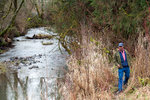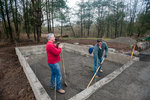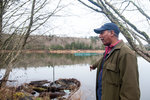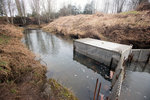




Rejuvenation projects are underway at Onalaska’s Carlisle Lake in an attempt to turn the area into an ecotourism destination.
The old mill town, located off of state Highway 508, is undergoing a major push for economic development with the help of the Onalaska Alliance, a nonprofit corporation with a stated mission “to develop innovative and sustainable economic and educational opportunities compatible with a rural lifestyle in Onalaska and the surrounding area.”
Currently, three grants are underway to help develop the area into a place where eventually members of the community would like to host festivals.
Previous projects within the area included the paving of the parking area, as well as the creation of an interpretive trail that goes around the lake.
Omroa Bhagwandin, who goes by the name of Harry, has been the grant writer for the projects.
Currently a two-phased grant, funding $171,000 for the project, is creating a bathroom right off of the paved parking area. Paul Sneed, project manager and owner of Sneed Construction, said the bathroom will have a covered patio on both sides, and will include an all timber frame with a roof of snap logs. The facility will include five bathroom stalls and a storage room.
The project was funded by the .09 grant fund, money made available through Lewis County for economic development. The money is available for qualifying public facilities improvements.
The second project currently ongoing was made possible through the Chehalis branch of the U.S. Department of Agriculture. The Environmental Quality Incentives Program is a voluntary program that provides technical and financial assistance to agriculture producers. According to Bhagwandin, the alliance is using the grant to rehab some of the wooded areas located on the 72-acre lot that houses the lake. The woods will be brushed out and thinned, creating day use picnic areas and a system of trails. In a way to invest in future generations, Bhagwandin said, 800 to 1,000 new trees will be planted in the area.
“What we are trying to do is we are trying to get this someday to generate revenue and I figure that timber is a good revenue,” he said.
One of the larger projects currently in the works is a $50,000 grant from the Environment Protection Agency, which in its first phase will allow the alliance to look at the feasibility and design of a fish passage, which would allow water to flow out of Carlisle Lake, creating a new exit route. In later phases of the grant, what is now known as the emergency spillway would be engineered as a fish passage. Bhagwandin said the current system in place, which involves a hole the water funnels into, is not a fish-friendly hole and does not allow fish to get back into Carlisle Lake.
Brian Taylor, the teacher of the aquaculture program and the woods and metals program at Onalaska High School, said the fish passage would be beneficial for the students. Although the program is not currently involved in the project, he said once completed, it would offer a good educational experience.
As of now the aquaculture program raises rainbow trout and coho in fish net pens, located toward the center of the lake. The students use hatchery fish from the Skookumchuck Hatchery, raise the fish and release them into the Newaukum Watershed, where the fish begin their journey to the ocean. To complete their life cycles, the fish come back to the area in about four years, said Taylor, and are captured in a fish trap located downstream from the lake.
“When we get them at the fish trap, we pull them out. If it’s a native fish we will release it upstream of the fish trap and the natives are allowed to spawn out,” Taylor said. “The hatchery ones are put back into the river system for nutrient enhancement.”
With a substantial knowledge on hatchery fish, the students would be able to further their knowledge on wild salmon with the fish passage.
“The great benefit would be improvement of that habitat,” he said. “It would be neat to be able to show students the way we used to do it, so they could see the best practices being used.”
In the first phase of the project, Bhagwandin said, they are focusing on the design, and acquiring permits from the state. The next step would be to collaborate with the Department of Fish and Wildlife to set up a design. The goal is to allow a passage of native fish into habitat they do not currently have access to.
“We like it because it has educational value and it gives sports fishermen more fish, but what we really want to do is we want to have wild fish coming up here,” Bhagwandin said.
Lewis County commissioners have been supportive of the projects at Carlisle Lake, helping to acquire the funds for the parking lot and restrooms. Commissioner Edna Fund said the goal is to bring fishermen and those who love nature to Onalaska, an unincorporated town.
As an Onalaska graduate, Fund is particular to the area and she sees the ecotourism push as one that is heading in the right direction.
“I think that would bring people there, and hopefully the restaurants would flourish,” she said, adding that it could provide an opportunity for more businesses to open in the area.
She also sees the fish passage as a way to enhance the students educational experience, allowing them to get a hands-on, first person experience.
“I always think when you have direct application from what you are learning from a teacher or a textbook, it’s easier to learn,” Fund said. “Seeing, doing, observing and learning, you just become better.”
She praised the alliance for its efforts in the Carlisle Lake area and said it truly helped bring the community together for a common cause, which she added will be beneficial to the town.
“The alliance is amazing and I just applaud them for bringing a lot of people together and putting some things together that Onalaska has to offer,” she said. “That’s no easy task when you are trying to pull people together.”
Although currently the three projects are in the works, they won’t be the end of the alliance’s efforts. Bhagwandin said they hope to establish a pavilion for events and further expand the trail system, while also developing salmon habitat upstream from the lake.
“This has been so unbelievable,” he said. “I have enough projects just on this piece of property for another ten years and then it will be something. It will be a destination spot.”